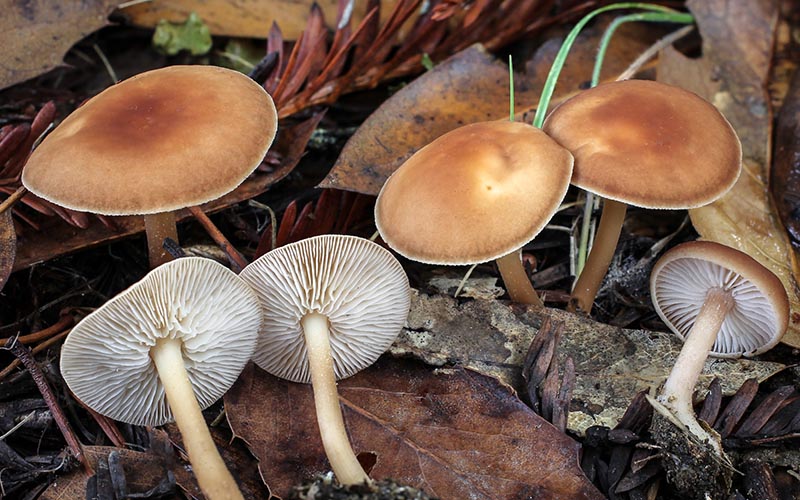Gymnopus dryophilus
N. Amer. Flora 9: 362. 1916.
Common Name: none
Synonym: Collybia dryophila
-
Pileus
Cap 2-5 cm broad, convex, expanding to nearly plane, sometimes slightly umbonate; margin incurved, becoming decurved, at maturity occasionally wavy to upturned; surface smooth, moist, hygrophanous, color varying from reddish-brown, ochraceous-brown to buff-brown, the margin lighter, in age fading to buff; flesh white, thin, unchanging; odor and taste mild.
-
Lamellae
Gills adnexed to notched, crowded, narrow, white to cream, unchanging.
-
Stipe
Stipe 2-6.5 cm tall, 3-6 mm thick, cartilaginous, equal to enlarged at the base, hollow; surface smooth, colored like the cap, white mycelium at the base; veil absent.
-
Spores
Spores 5-7.5 x 3-4 µm, elliptical, smooth, non-amyloid; spore print white to pale cream.
-
Habitat
Gregarious under oaks (Quercus); fruiting shortly after the fall rains.
-
Edibility
 Edible, but opinions vary on its culinary value; the stipes are tough and should be discarded.
Edible, but opinions vary on its culinary value; the stipes are tough and should be discarded. -
Comments
This honey-brown to buff-brown, hygrophanous Gymnopus lives up to its species name, seldom venturing far from oaks. A close cousin, Rhodocollybia butyracea, is similarly colored, but has a lubricous cap, gills with finely scalloped edges, a cream spore print with a hint of pink, and a faintly striate stipe. It is more common under conifers but can occur in other habitats.
-
References
Ammirati, J.F., Traquair, J.A. & Horgen, P.A. (1985). Poisonous Mushrooms of the Northern United States and Canada. University of Minnesota Press: Minneapolis, MN. 396 p.
Antonín, V. & Noordeloos, M.E. (1997). A Monograph of Marasmius, Collybia and related general in Europe. IHW - Verlag: Eching, Germany. 256 p.
Arora, D. (1986). Mushrooms Demystified. Ten Speed Press: Berkeley, CA. 959 p.
Bas, C., Kyper, T.W., Noordeloos, M.E. & Vellinga, E.C. (1995). Flora Agaricina Neerlandica — Critical monographs on the families of agarics and boleti occuring in the Netherlands. Volume 3. Tricholomataceae. A. A. Balkema: Rotterdam, Netherlands. 183 p.
Breitenbach, J. & Kränzlin, F. (1991). Fungi of Switzerland. Volume 3: Boletes and Agarics (1st Part). Strobilomycetaceae, Boletaceae, Paxillaceae, Gomphidiaceae, Hygrophoraceae, Tricholomataceae, Polyporaceae (lamellate). Verlag Mykologia: Luzern, Switzerland. 361 p
Desjardin, D.E., Wood, M.G. & Stevens, F.A. (2015). California Mushrooms: The Comprehensive Identification Guide. Timber Press: Portland, OR. 560 p.
Knudsen, H. & Vesterholt, J. ed. (2008). Funga Nordica: Agaricoid, boletoid and cyphelloid genera. Nordsvamp: Copenhagen, Denmark. 965 p. (PDF)
Knudsen, H. & Vesterholt, J. ed. (2012). Funga Nordica: Agaricoid, boletoid, clavarioid, cyphelloid and gastroid genera. Vol. 1. Nordsvamp: Copenhagen, Denmark. 511 p.
Halling, R.E. (1983). The Genus Collybia (Agaricales) in the Northeastern United States and Adjacent Canada. J. Cramer: Braunschweig, Germany. 148 p.
Siegel, N. & Schwarz, C. (2016). Mushrooms of the Redwood Coast. Ten Speed Press: Berkeley, CA. 601 p.
Smith, A.H. (1949). Mushrooms in their Natural Habitats. Sawyer's Inc: Portland, OR. 626 p. (PDF)
-
Other Descriptions and Photos
- Michael Wood: Gymnopus dryophilus (CP)

- Michael Wood: Gymnopus dryophilus (CP)

- Michael Wood: Gymnopus dryophilus (CP)

- Michael Wood: Gymnopus dryophilus (CP)

- Fred Stevens: Gymnopus dryophilus (CP)

- A revision of Collybia s.l. in the northeastern United States and adjacent Canada: Gymnopus dryophilus (D & CP)
- Macrofungi of Costa Rica: Gymnopus dryophilus (D & CP)
- Boston Mycological Club: Gymnopus dryophilus (D & CP) [as Collybia dryophila]
- MushroomExpert.com: Gymnopus dryophilus (D & CP) [as Collybia dryophila]
- Mushroom Observer: Gymnopus dryophilus (CP)
- Arora (1986): p. 215 (D), p. 216 (P) [asCollybia dryophila]
- Halling: p. 49 (D), fig 37-40 (I), fig. 103 (P) [as Collybia dryophila]
- Jordan: p. 152 (D & CP) [as Collybia dryophila]
- Lincoff: p. 755 (D), plate 80 (CP) [as Collybia dryophila]
- McKenny et al.: p. 56 (D & CP)
- Phillips: p. 60 (D & CP) [as Collybia dryophila]
- Smith & Weber: sp. 117 (D & CP) [as Collybia dryophila]
- Michael Wood: Gymnopus dryophilus (CP)
